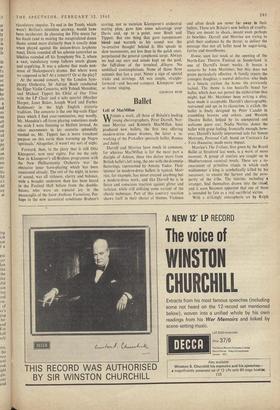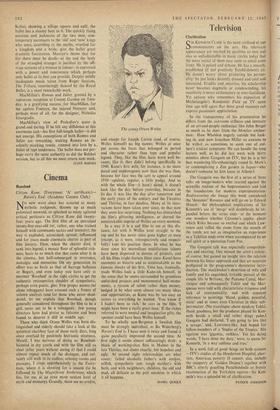Ballet
Left of MacMillan
WITHIN a week, all three of Britain's leading young choreographers, Peter Darrell, Nor- man Morrice and Kenneth MacMillan, have produced new ballets, the first two offering modern-dress dance dramas, the latter a re- working of the Prokofiev spectacle ballet, Romeo and Juliet.
Darrell and Morrice have much in common, for whereas MacMillan is for the most part a disciple of Ashton, these two derive more from British ballet's left wing, the one with the dramatic flutterings, represented by Antony Tudor. Their interest in modern-dress ballets is typical. Mot- rice, for example, has never created anything but a modern-dress work, and like Darrell he is in fierce and conscious reaction against glitter and tarlatan, while still utilising some variant of the classic technique. Part of this contrary reaction shows itself in their choice of themes. Violence and often death are never far away in their - ballets. These are Britain's new ballets of cruelty. They are meant to shock, meant even perhaps to bewilder. Darrell and Morrice are trying to grab their audience by the throat, to deliver the message that not all ballet need be sugar-icing, fairies and moonbeams.
Home, seen last week at the opening of the North-East Theatre Festival in Sunderland, is one of Darrell's lesser works. It boasts a scenario by John Mortimer, but this does not prove particularly effective. A family rejects the youngest daughter. a mental defective, who finds in a lunatic asylum the home she previously lacked. The theme is too basically banal for ballet, which does not permit the elaboration that might, had Mr. Mortimer been writing a play, have made it acceptable. Darrell's choreography, restrained and apt in its classicism, is stylish, the ballet is finely designed by Peter Cazalet in crumbling browns and ochres. and Western Theatre Ballet, helped by its unexpected and welcome guest star, Nadia Nerina, dance the ballet with great feeling. Ironically enough, how- ever, Darrell's hastily improvised solo for Simon Mottram, Personal Call, based on Cocteau's La Par Humaine, made more impact.
Morrice's The Tribute, first given by the Royal Ballet at Stratford last week, is a work of more moment. A group of tourists are caught up in Mediterranean carnival revels. These are a re- enactment of primitive rituals in which each midsummer a king is symbolically killed by his successor, to ensure the harvest and the pros- perity of the tribe. The tourists. including a stranger, find themselves drawn into the ringat, and it soon becomes apparent that one of them is intended by fate as a real sacrificial victim.
With a strikingly atmospheric set by Ralph
Koltai, showing a village square and cafe, the ballet has a steamy heat to it. The quickly rising passions and jealousies of the two men, con- temporary successors to the `old' and 'new' kings who once, according to the myths, wrestled for a kingdom and a bride, give the ballet great dramatic fascination. Morrice's theme that for life there must be death—at the end the body of the strangled stranger is justified by the off- stage screams of a woman in labour—is expressed with a power and conciseness which perhaps only ballet at its best can provide. Despite mildly inadequate music taken from Roger Sessions, The Tribute, convincingly danced by the Royal Ballet, is a most remarkable work.
MacMillan's Romeo and Juliet, greeted by a rapturous reception at Covent Garden on Tues- day, is a gratifying success, for MacMillan, for the ageless Fonteyn, the injured Nureyev and, perhaps most of all, for the designer, Nicholas Georgiadis.
MacMillan's view of Prokofiev's score is grand and daring. If he felt any diffidence at this enormous task—his first full-length ballet—it did not emerge. His conceptions of both Romeo and Juliet are rewarding, making Romeo an in- solently mocking rowdy, stunned into love by a. Juliet of rapt tenderness. The ballet does not per- haps carry the same authority as did the Bolshoi version, but to all this we must return next week.
CLIVE BARNES


































 Previous page
Previous page